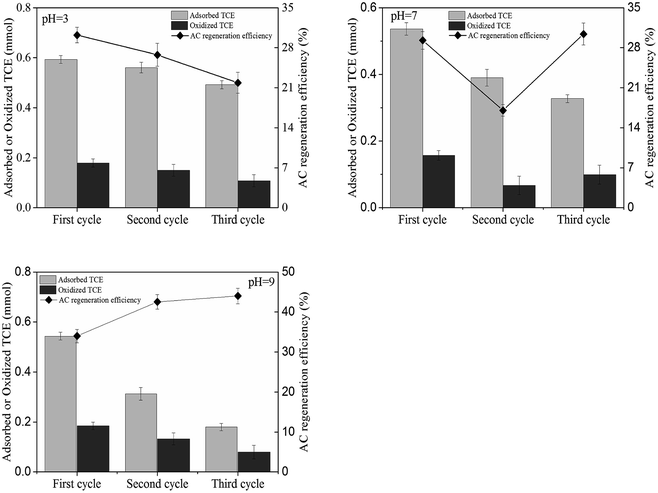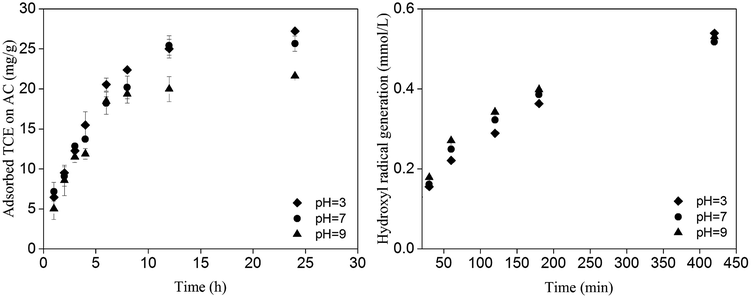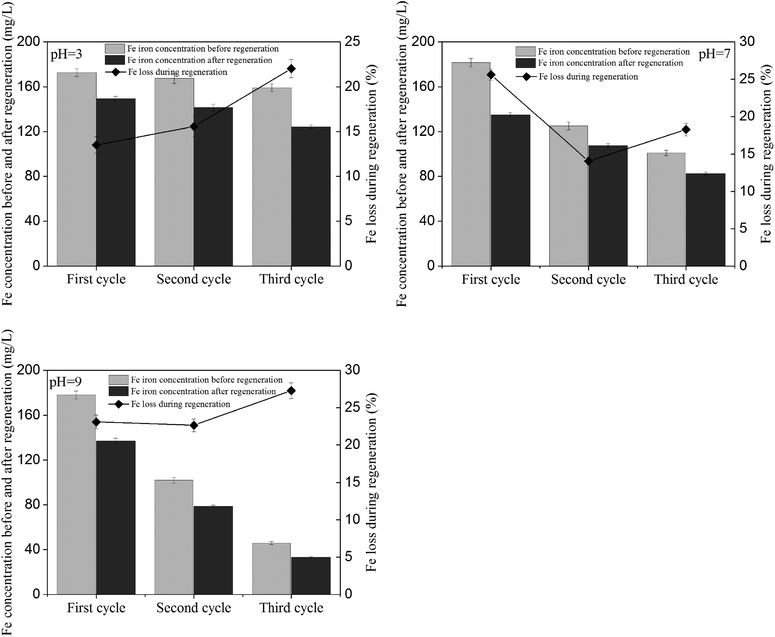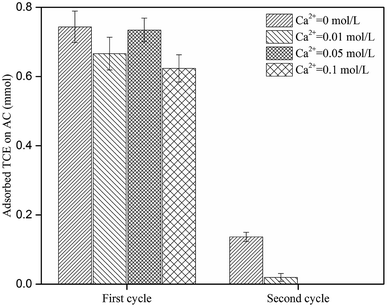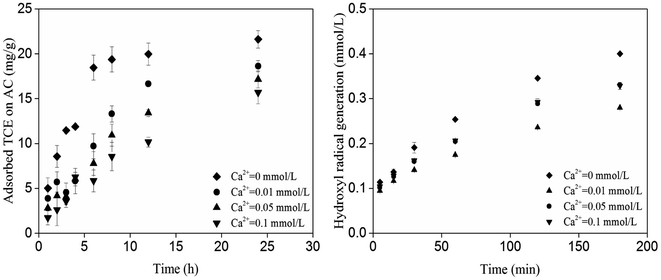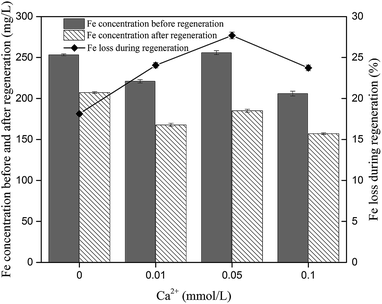 Open Access Article
Open Access ArticleEffects of calcium ion and pH on the adsorption/regeneration process by activated carbon permeable reactive barriers
Shengpin Liab,
Wenpeng Lia,
Honghan Chenb,
Fei Liu†
 *b,
Song Jincd,
Xiulan Yina,
Yuejun Zhenga and
Boyang Liub
*b,
Song Jincd,
Xiulan Yina,
Yuejun Zhenga and
Boyang Liub
aChina Institute of Geo-Environment Monitoring, Beijing 100081, P. R. China
bBeijing Key Laboratory of Water Resources and Environmental Engineering, China University of Geosciences, Beijing 100083, P. R. China. E-mail: feiliu@cugb.edu.cn
cDepartment of Civil and Architectural Engineering, University of Wyoming, 1000 East University Avenue, Laramie, Wyoming 82071, USA
dAdvanced Environmental Technologies LLC, 4025 Automation Way, Suite F4, Fort Collins, Colorado 80525, USA
First published on 8th May 2018
Abstract
Activated carbon (AC) is widely used in groundwater remediation, more specifically, for the activated carbon permeable barriers (AC-PRBs). However, the long-term use of AC-PRBs is limited by the AC's adsorption capacity. In this work, a Fenton-combined persulfate system (Fe2+/H2O2/S2O82−) was used to treat activated carbon that was saturated with organic compounds, such as trichloroethylene (TCE), to promote the oxidation of the adsorbed contaminants and the regeneration of AC. The effect of pH and the calcium ion (Ca2+) were investigated during AC's adsorption/regeneration. The results showed that under certain reaction conditions (TCE/Fe2+/H2O2/S2O82− molar ratio of 1.00/9.00/56.63/76.25), acidic pH conditions (pH = 3) favored the adsorption/regeneration process of AC, yielding a regeneration efficiency of 26.28% on average in three regeneration cycles. The presence of Ca2+, even in relatively low concentrations, seemed to decrease HO˙ generation and AC's adsorption capacity.
1 Introduction
Activated carbon (AC) is widely used in groundwater remediation and wastewater treatment, thanks to its high surface area and porous structure, which can physically adsorb a variety of contaminants, especially in terms of its interaction with volatile organic compounds (VOCs).1–7 AC has been used as an adsorbent for organic contaminants in a range of permeable reactive barriers (PRBs),8,9 especially for the remediation of groundwater contaminated by chlorinated organic compounds.10 To better utilize the AC-PRBs, differently designed structures of the PRBs were investigated and applied in groundwater remediation.11 PRB offers the potential for low-cost remediation, taking advantage of the passive groundwater flow to bring the contaminants in contact with the reactive materials in the barrier.12,13 However, AC-PRBs are limited by AC's adsorption capacity.The regeneration of AC can transform the contaminants into less toxic byproducts, re-establish the adsorptive capacity of the carbon for the target chemicals, and increase its lifespan.14 Several methods have been studied for the regeneration of AC saturated with organic contaminants. The advanced oxidation process (AOPs) is one of the most promising methods to treat aqueous effluents containing organic contaminants.15,16 Available AOP approaches to regenerate AC include Fenton's reagent (Fe2+/H2O2), persulfate oxidation (Fe2+/S2O82−) and a Fenton-combined persulfate system (Fe2+/H2O2/S2O82−).15,17,18
The results of the Fe2+/H2O2/S2O82− system in the regeneration of AC saturated with organic compounds were promising.19–21 In particular, both H2O2 and S2O82− in the Fe2+/H2O2/S2O82− system can be catalyzed by Fe2+ to avoid the consumption of SO4−˙ by excess Fe2+ and improve the production of the hydroxyl radical (HO˙).22,23 Furthermore, the pH of the reaction environment was decreased as a result of S2O82−, which would favor the reaction and avoid iron precipitation.24
Despite the Fe2+/H2O2/S2O82− system's promising results, the adsorption/regeneration processes are known to be affected by several environmental factors, including pH, temperature, salinity and chemical composition,25 particularly,26 which play an important role in the efficiency of oxidants. Moreover, pH and Ca2+ alter the surface charge and polarity of AC, resulting in different adsorption properties for contaminants.27 The adsorption capacity of AC is strongly unfavored by a high O content. In an alkaline environment, the O amount in the surface of the AC increased and resulted in a decrease of its adsorption capacity.27,28 Iron ion (Fe2+ and Fe3+) concentrations played an important role in the oxidation ability of the Fe2+/H2O2/S2O82− system, and are strongly affected by pH. Kilduff and Karanfil29 pointed out that the increasing concentrations of Ca2+ lead to a decrease in trichloroethylene (TCE) adsorption by activated carbon. Heo et al.26 stated that the solution ionic strength, mainly with cations (i.e. Ca2+, Mg2+, Na+), affects the TCE adsorption on granular activated carbon from synthetic groundwater. Ca2+ in groundwater easily precipitates and complexes, which might have a negative effect on the efficiency of the Fe2+/H2O2/S2O82− system. Previous research into AC regeneration by Fe2+/H2O2/S2O82− system mainly focused on the re-establishment of AC's adsorption capacity, but the effects of pH and Ca2+ on the regeneration are still under debate.
In order to reveal the interactions of pH, Ca2+, AC and oxidants during the regeneration process of AC, the Fe2+/H2O2/S2O82− system was used to regenerate the AC saturated with TCE, and the effects of pH and Ca2+ on the adsorption/regeneration process of AC were investigated. The adsorption/regeneration process of AC was conducted in three cycles to evaluate the variation of AC's adsorption capacity. Both physical and chemical AC properties, such as BET surface area and chemical composition during the adsorption/regeneration process, were evaluated. The significance of the study will provide some insights in the application of AC-PRBs in groundwater remediation; furthermore, environmental factors (pH and Ca2+) that affect the adsorption/regeneration process of AC-PRBs are discussed, which can help us to understand the mechanisms of AC regeneration and support the sustainable use of AC-PRBs in groundwater.
2 Materials and methods
2.1 Chemicals
All the chemicals used in this study were prepared with ultrapure water from a Millipore system. Granular AC (20–40 mesh) was purchased from Sigma-Aldrich and used as the adsorbent for TCE. Trichloroethylene was the selected contaminant (C2HCl3, TCE ≥ 98%). Ferrous sulfate heptahydrate (FeSO4·7H2O, ≥99%), hydrogen peroxide (H2O2, ≥30%) and sodium persulfate (Na2S2O8, ≥98%) were used as the oxidation system to regenerate saturated AC. Benzoic acid (C6H5COOH, ≥98%) was used as a radical scavenger to capture HO˙. p-Hydroxybenzoic acid (C7H6O3, ≥98%) was the product of benzoic acid and HO˙, and was used as a standard material for HO˙ detection. Calcium chloride (CaCl2, ≥96%) was used to adjust the concentration of Ca2+ during the experiment. H2SO4 and NaOH were used to adjust the pH in the experiment. Ascorbic acid (C6H8O6, ≥98%) was used to terminate the radical reactions during the regeneration process. Chemicals were all analytical grade reagents and obtained from Beijing Chemical Works (Beijing, China).2.2 Experiment design
All the experiments were conducted in batch mode and in non-buffered solutions under ambient room temperature. The initial pH of samples was adjusted with H2SO4 (1 mol L−1) and NaOH (1 mol L−1). All the experiments were conducted in a 2 L conical flask with a Teflon coated plug and a magnetic stirring apparatus. The reaction liquid was stirred with a magnetic stirrer that had an adjustable agitation rate (150 rpm). Experiments, including controls, were set up in triplicate. The ascorbic acid was used to terminate the radical reactions. Adsorption three times was selected in the experiments because a 3 times adsorption not only achieves a high TCE removal efficiency, but also enough TCE can be adsorbed in AC. 479 samples were taken in the experiments, including the effect of pH on TCE removal and HO˙ generation tests (147 samples), the effect of pH on the adsorption/regeneration and iron loss tests (108 samples), the effect of pH on AC's surface characters (4 samples), the effect of Ca2+ concentrations on TCE removal and HO˙ generation tests (168 samples), the effect of Ca2+ concentrations on the adsorption/regeneration and iron loss tests (48 samples) and the effect of Ca2+ on AC's surface characters (4 samples).In the regeneration process of AC, the adsorption process was conducted first, while the solution pH was fixed at 7, the reaction time was selected for 12 h (according to the results from kinetic tests when the adsorption equilibrium was achieved). The adsorption processes were conducted 3 times to help the AC saturate (not fully saturated), the saturated AC was then freeze-dried to help regeneration. Based on the adsorbed TCE amount, the solution's pH was adjusted to 3, 7 and 9, respectively; oxidants with a TCE/Fe2+/H2O2/S2O82− molar ratio of 1.00/9.00/56.63/76.25 (obtained from our previous study) were then added. The adsorption/regeneration cycle was repeated 3 times. TCE, HO˙, and chloride concentrations were analyzed during the reactions.
For the regeneration process of AC, the adsorption process was conducted first (Ca2+ = 0 mol L−1), while the solution pH was fixed at 7, and the reaction time was selected for 12 h. The adsorption processes were conducted 3 times to help the AC saturate (not fully saturated), the saturated AC was then freeze-dried to help regeneration. Based on the adsorbed TCE amount, the Ca2+ concentration in the solution was adjusted to 0.01, 0.05 and 0.1 mol L−1, and then the oxidants added with a TCE/Fe2+/H2O2/S2O82− molar ratio of 1.00/9.00/56.63/76.25. The adsorption/regeneration cycle was repeated 3 times. TCE, HO˙ and chloride concentrations were analyzed during the reactions.
2.3 Analytical methods
TCE was analyzed by using an Agilent GC-6820 with a headspace autosampler (HP 7694E), a FID detector and a 30 m × 0.53 mm DB-5 capillary column (film thickness 1.5 μm). The total iron ion (Fe) amounts were analyzed by ICP-OES (Spectroblue, Germany). The value of pH was determined by using a Sartorius PB-10 pH meter. In order to investigate the HO˙ concentrations, benzoic acid was selected as the radical scavenger.30 Benzoic acid and p-Hydroxybenzoic acid were determined by using an Agilent 1220 HPLC that was equipped with a ZORBAX SB-Aq column (5 μm, 4.6 × 150 mm) and HPLC-UV detection at 240 nm. Chloride was determined by Silver nitrate titration (0.01 mol L−1) by using an automatic potentiometric titrator (Metrohm 877 Titrino plus equipped with a Metrohm 801 stirrer, Switzerland). An Escalab 250Xi X-ray photoelectron spectrometer (Thermo Scientific, USA) was used to assess the surface element change of the AC. Pore size and volume were determined by using an ASAP2020 physical adsorption instrument (Micromeritics Instrument Corp, USA).3 Results and discussion
3.1 Effect of pH on AC adsorption/regeneration process
The variation of pH resulted in a change of the AC's surface charge and affected the adsorption properties.27 As presented in Fig. 1, adsorption/regeneration cycles were conducted three times under different pH conditions. The left Y-axis of Fig. 1 represents the TCE amount that adsorbed or oxidized during the adsorption/regeneration cycles, the right Y-axis of Fig. 1 represents the regeneration efficiency of TCE during the adsorption/regeneration cycles. TCE was finally oxidized to chloride during the regeneration (1 molar TCE can finally generate 3 molar chloride; no intermediates were detected), which means that chloride can represent the oxidized amount of TCE. The generated chloride divided by 3 was the oxidized TCE amount (in a molar ratio). The regeneration efficiency was expressed as eqn (1). It was observed that the Fe2+/H2O2/S2O82− system was very efficient in oxidizing TCE that adsorbed on the surface of AC (eqn (2) and (3)). During the first regeneration cycle, 30.22%, 29.29% and 33.98% of the TCE was mineralized to chloride under different pH conditions of 3, 7 and 9, respectively (Fig. 1). However, during the second and the third regeneration cycles, the regeneration efficiency of AC decreased to 26.75% and 21.87% with a pH of 3. Due to the decrease in TCE adsorption with a pH of 7 and 9 (Fig. 1), the regeneration efficiency of AC increased to 42.52% and 44.01% with a pH of 9, decreased to 17.04% and then increased to 30.41% with a pH of 7.
 | (1) |
| Fe2+ + H2O2 → Fe3+ + HO˙ + OH− | (2) |
| S2O82− + Fe2+ → SO4−˙ + SO42− + Fe3+ | (3) |
Although the highest regeneration efficiency of AC was achieved with pHs of 7 and 9, the adsorption capacity of AC decreased after regeneration. In comparison, at pH 3 the adsorption capacity of AC was stable, indicating that a low pH was favorable for AC's long-term adsorption/regeneration (Fig. 1).
The TCE adsorption capacity is strongly unfavored by a high O content; in fact, the presence of O made the AC surface more polar and, consequently, decreased the adsorption capacity of AC.27,28 In an alkaline environment, the O amount in the surface of the AC increased and resulted in a decrease of its adsorption capacity. As shown in Fig. 2, with pH increasing, the adsorbed TCE on AC decreased, and it can be observed that the highest TCE adsorption occurred at pH = 3, confirming that an acidic condition is favorable for the adsorption process of AC (Fig. 2). The HO˙ concentration represented the efficiency with which the oxidized TCE was adsorbed on the AC's surface during the regeneration process. Because of the initial addition of persulfate, an acidic condition was created, so there was little change in HO˙ generation with pH at 3, 7 and 9 (Fig. 2), suggesting that the Fe2+/H2O2/S2O82− system possessed a high oxidation ability with pH ranging from 3 to 9.
Iron ions (Fe2+ and Fe3+) played an important role on the surface character of AC and the oxidation ability of the Fe2+/H2O2/S2O82− system; however, iron precipitation might adversely impact the oxidants and the adsorption capacity of AC. Iron precipitation was mainly determined by pH and the iron concentration. Despite the adjustment of pH by persulfate, iron precipitation was inevitable during the reaction. As presented in Fig. 3, the iron losses with pH = 3, 7 and 9 in the first regeneration cycle were 14.94%, 22.24% and 24.35%, respectively. However, it was obvious that the input iron of the oxidation systems decreased at pHs of 7 and 9, indicating that the adsorption capacity of AC decreased, which resulted in a decrease of adsorbed TCE on AC. For a pH of 9, there was a significant iron loss during regeneration compared with pHs of 3 and 7, suggesting that an alkaline environment is favorable for iron precipitation. Though the pH of 7 possessed a better iron loss control, considering the stability of AC's adsorption capacity, pH 3 is more suitable for the adsorption/regeneration process of AC.
The effect of pH on the physico-chemical characteristics of AC was investigated. Acidic conditions not only exhibited good iron loss prevention (Fig. 3), they also resulted in the highest adsorption capacity of AC (Fig. 1). Table 1 presents the element changes under different pH conditions, and it can be observed that after the regeneration, the Fe contents were 2.38%, 0.87% and 0.73% for pH 3, 7 and 9, respectively. Due to the high AC adsorption capacity in the acidic condition (pH 3), the addition of the oxidant amount was higher, resulting in an increase of iron content in the surface of AC (Table 1). Compared with the initial AC, the accumulation of iron on the AC surface was significant, especially at pH = 3. It can be observed that the Fe content increased at pH 3 (from 0.32% to 2.38%) in comparison with 0.87% and 0.73% at pH 7 and pH 9, respectively. The chloride content (representing the TCE content) increased from 0.14% to 0.58%, 1.44% and 1.53% at pH 3, pH 7, and pH 9, respectively. The contents of Cl under pHs of 3, 7 and 9 were 0.58%, 1.44% and 1.53%, respectively, suggesting that acidic pH conditions with the least Cl reservation favored TCE removal. However, acidic pH conditions promote contaminant removal by the Fe2+/H2O2/S2O82− system, which could result in a mass loss of the AC.
| Elements | Initial AC (wt%) | Final AC (pH = 3) (wt%) | Final AC (pH = 3) (wt%) | Final AC (pH = 9) (wt%) |
|---|---|---|---|---|
| C | 70.84 | 45.76 | 56.67 | 61.31 |
| N | 0.00 | 0.00 | 0.00 | 0.00 |
| O | 9.48 | 28.24 | 28.55 | 28.79 |
| Na | 0.13 | 0.15 | 0.10 | 0.17 |
| Al | 1.31 | 9.35 | 0.99 | 0.90 |
| Si | 15.57 | 12.35 | 6.83 | 2.62 |
| P | 0.91 | 0.82 | 1.46 | 1.47 |
| S | 0.52 | 0.11 | 1.83 | 2.36 |
| Cl | 0.14 | 0.58 | 1.44 | 1.53 |
| Ti | 0.77 | 0.26 | 1.28 | 0.11 |
| Fe | 0.32 | 2.38 | 0.87 | 0.73 |
The surface area of the AC during regeneration under different pH conditions showed that acidic conditions were more favorable for the protection of the AC surface area (Table 2). However, there was an approximately 32.85% decline in the BET surface area of the AC that occurred at pH 3 after three regeneration cycles, which was attributed to iron accumulation and carbon mass loss of the AC surfaces.31
| Category (m2 g−1) | Initial AC | Final AC (pH = 3) | Final AC (pH = 7) | Final AC (pH = 9) |
|---|---|---|---|---|
| BET surface area | 637.41 | 437.99 | 433.92 | 418.07 |
| Langmuir surface area | 1267.26 | 1001.43 | 988.03 | 949.33 |
| t-plot pore area | 452.07 | 269.41 | 272.33 | 265.33 |
| t-plot external surface area | 185.34 | 168.59 | 234.21 | 152.74 |
In general, despite iron precipitation, the loss of carbon mass and the decrease of AC surface area, high adsorption and removal of TCE during the regeneration suggested that an acidic pH favored AC's adsorption/regeneration process.
3.2 Effect of Ca2+ on AC adsorption/regeneration process
Due to its relatively low solubility in compound form, Ca2+ in groundwater easily precipitates and complexes. It was widely accepted that pH and ionic strength do not affect the adsorption of uncharged organic compounds on activated carbon.27,32 However, the influence of the presence of Ca2+ in solutions on the adsorption capacity of AC and the oxidation ability of the Fe2+/H2O2/S2O82− system is still a debated subject. It is widely known that CaSO4 and CaCO3 easily precipitate in groundwater; apparently, SO42−and CO32− are the products of the Fe2+/H2O2/S2O82− system. It is possible that due to the presence of Ca2+, the adsorption capacity of AC may be affected.As presented in Fig. 4, two adsorption/regeneration cycles were conducted. During the first adsorption/regeneration cycle, TCE removal decreased obviously when Ca2+ was present. It was apparent that during the second adsorption/regeneration cycle, even though the regeneration of AC was carried out, it had difficulty in removing TCE in the presence of Ca2+ conditions. This indicated that Ca2+ could play an important role not only in AC's adsorption capacity, but also in its regeneration process. The reasons might owe to the combination of Ca2+ with other ions, especially for SO42−and CO32−, which generate from S2O82− (eqn (3)) and TCE degradation, respectively, which easily precipitate on the surface of the AC and affect the adsorption capacity of it, resulting in a decrease in TCE removal in the second cycle.
The presence of Ca2+ also showed an influence on the oxidation ability of oxidants, the adsorption capacity of AC, and the formation of iron ions in solution. When Ca2+ was present, the generation of HO˙ decreased significantly, as Fig. 5 shows. Without Ca2+ in the regeneration process, the generation of HO˙ was much higher than that with Ca2+ present, suggesting that Ca2+ decreased the oxidation ability of the Fe2+/H2O2/S2O82− system. As with the variation of AC's adsorption capacity when Ca2+ was present, it can be observed that the amount of adsorbed TCE on the AC decreased obviously (Fig. 5). Compared with the reaction system without Ca2+, the adsorption of AC decreased as the Ca2+ concentration increased, indicating a negative effect of Ca2+ on the adsorption capacity of AC.
The iron loss during the regeneration of AC is presented in Fig. 6. Compared with the input Fe concentration before regeneration, the Fe concentration decreased significantly after regeneration. Even without the presence of Ca2+, iron loss also happened. The iron loss at Ca2+ concentrations of 0.01, 0.05 and 0.1 mmol L−1 were 24.05%, 27.68% and 23.73%, respectively, compared with the control (without Ca2+) in which 18.14% of iron loss occurred in the absence of Ca2+. Iron loss increased when Ca2+ was present, which indicated that Ca2+ precipitation formed by Ca2+ promoted the iron loss during the regeneration process of AC.
It can be observed that in the presence of Ca2+, the mass loss of C increased after the regeneration of AC (Table 3). The C content on the surface of the AC was 75.57% without Ca2+, compared with that of 69.89%, 59.25% and 49.32% under Ca2+ concentrations of 0.01, 0.05 and 0.1 mmol L−1, respectively. The C content was directly related with the adsorption capacity of the AC, further indicating that Ca2+ can decrease the AC's adsorption capacity. The content of iron in the AC surface decreased in the presence of Ca2+, suggesting that the complexation of Ca2+ and Fe ions mainly occurred in solution rather than on the AC surface. The Cl level increased substantially on the surface of the AC in the presence of Ca2+, proving that Ca2+ decreased the regeneration efficiency of AC.
| Elements | Initial AC (wt%) | Ca2+ = 0 mmol L−1 (wt%) | Ca2+ = 0.01 mmol L−1 (wt%) | Ca2+ = 0.05 mmol L−1 (wt%) | Ca2+ = 0.1 mmol L−1 (wt%) |
|---|---|---|---|---|---|
| C | 70.84 | 75.57 | 69.89 | 59.25 | 49.32 |
| N | 0.00 | 0.00 | 0.00 | 0.00 | 0.00 |
| O | 9.48 | 6.70 | 19.94 | 27.36 | 28.78 |
| Na | 0.13 | 0.32 | 0.29 | 0.72 | 0.99 |
| Al | 1.31 | 8.13 | 0.89 | 7.98 | 5.90 |
| Si | 15.57 | 6.39 | 1.80 | 15.62 | 12.38 |
| P | 0.91 | 0.87 | 1.46 | 1.48 | 0.89 |
| S | 0.52 | 0.23 | 1.34 | 0.56 | 0.15 |
| Cl | 0.14 | 0.51 | 2.63 | 2.64 | 0.69 |
| Ti | 0.77 | 0.36 | 0.43 | 0.46 | 0.23 |
| Fe | 0.32 | 0.91 | 0.34 | 0.42 | 0.66 |
Comparing the AC surface area with and without Ca2+, it was found that Ca2+ did not influence the surface area of the AC (Table 4). Looking at the change of the AC's surface area and Fe content, it can be inferred that the complexation of Ca2+ and Fe ions occurred in solution and then reduced the iron precipitation on the AC's surface. Furthermore, the consumption of HO˙ in the presence of Ca2+ eliminated the deterioration of the AC surface structure.
| Category (m2 g−1) | Initial | Ca2+ = 0 mmol L−1 | Ca2+ = 0.01 mmol L−1 | Ca2+ = 0.05 mmol L−1 | Ca2+ = 0.1 mmol L−1 |
|---|---|---|---|---|---|
| BET surface area | 637.41 | 457.21 | 447.50 | 395.35 | 450.81 |
| Langmuir surface area | 1267.26 | 1033.59 | 999.60 | 927.88 | 995.31 |
| t-plot pore area | 452.07 | 269.63 | 286.04 | 242.84 | 294.75 |
| t-plot external surface area | 185.34 | 187.59 | 161.46 | 152.51 | 156.06 |
Overall, the influence of Ca2+, even at low concentrations, appeared to be evident on the HO˙ generation and the AC adsorption capacity and regeneration.
Based on the results obtained from the experiments, it can be concluded that AC-PRB is a valuable approach for groundwater management. It requires refinement, as several environmental factors played a negative effect on the PRBs, including pH and Ca2+, but it has the advantages of an immediate organic contamination removal followed by a sustainable use that employs the adsorption/regeneration process.
4 Conclusion
Under certain reaction conditions (TCE/Fe2+/H2O2/S2O82− molar ratio of 1.00/9.00/56.63/76.25), compared with the pHs of 7 and 9, the adsorption capacity of AC under pH 3 decreased less after regeneration, indicating a sustainable use of AC-PRBs under an acidic pH condition. Even though the iron precipitation, C mass loss, and the decrease of the AC surface area were higher under a pH of 3, a high adsorption and removal of TCE during the regeneration suggested that an acidic pH favored AC's adsorption/regeneration process. The presence of Ca2+, even at low concentrations, could decrease HO˙ generation and AC adsorption capacity. Ca2+ or precipitation formed by Ca2+ promoted the iron loss during the regeneration process of AC, which resulted in iron precipitation in solutions rather than on the surface of the AC. Moreover, the consumption of HO˙ in the presence of Ca2+ eliminated the deterioration of the AC surface structure.Conflicts of interest
There are no conflicts to declare.Acknowledgements
This work was financially supported by the National Natural Science Foundation of China (NSFC) (41272268), the Special Fund for Public Interest research support by the Ministry of Environmental Protection (201309001-3), the Fundamental Research Funds for the Central Universities, and China Scholarship Council (201506400018) and National Grade Geological Environment Monitoring and Forecast (121201014000150003).References
- T. n. Dobre, O. C. Pârvulescu, G. Iavorschi, M. Stroescu and A. a. Stoica, Ind. Eng. Chem. Res., 2014, 53, 3622–3628 CrossRef CAS.
- D. T. Tefera, M. Jahandar Lashaki, M. Fayaz, Z. Hashisho, J. H. Philips, J. E. Anderson and M. Nichols, Environ. Sci. Technol., 2013, 47, 11700–11710 CrossRef CAS PubMed.
- A. D. Luz, S. M. d. A. Guelli Ulson de Souza, C. da Luz, R. V. d. P. Rezende and A. n. A. Ulson de Souza, Ind. Eng. Chem. Res., 2013, 52, 7896–7911 CrossRef CAS.
- J. Zhang, W. Zhu, M. Makkee, B. Van der Linden, F. Kapteijn and J. Moulijn, J. Chem. Eng. Data, 2001, 46, 662–664 CrossRef CAS.
- Y.-f. Su, Y.-l. Cheng and Y.-h. Shih, J. Environ. Manage., 2013, 129, 361–366 CrossRef CAS PubMed.
- K. S. Walton, C. L. Cavalcante Jr and M. D. Levan, Adsorption, 2005, 11, 107–111 CrossRef CAS.
- Y.-C. Chiang, P.-C. Chiang and C.-P. Huang, Carbon, 2001, 39, 523–534 CrossRef CAS.
- B. Bone, Review of UK guidance on permeable reactive barriers, 2012 Taipei International Conference on Remediation and Management of Soil and Groundwater Contaminated Sites, Taipei, Taiwan, 2012, pp. 611–768 Search PubMed.
- M. Turner, A. Sogorka, N. Dave, M. Duchene, B. Dwyer, D. Hubble, L. Kessel, W. Khan, J. Liskowitz and P. Lurk, Technical/Regulatory Guidelines: Permeable Reactive Barriers: Lessons Learned/New Directions, 2005 Search PubMed.
- A. Erto, I. Bortone, N. A. Di, N. M. Di and D. Musmarra, J. Environ. Manage., 2014, 140, 111–119 CrossRef CAS PubMed.
- I. Bortone, A. Erto, G. Santonastaso, A. D. Nardo, M. D. Natale and D. Musmarra, Desalin. Water Treat., 2015, 55, 3231–3240 CrossRef CAS.
- L. Carniato, G. Schoups, P. Seuntjens, T. Van Nooten, Q. Simons and L. Bastiaens, J. Contam. Hydrol., 2012, 142–143, 93–108 CrossRef CAS PubMed.
- B. M. Patterson, M. E. Grassi, B. S. Robertson, G. B. Davis, A. J. Smith and A. J. McKinley, Environ. Sci. Technol., 2004, 38, 6846–6854 CrossRef CAS PubMed.
- S. G. Huling, P. K. Jones, W. P. Ela and R. G. Arnold, Water Res., 2005, 39, 2145–2153 CrossRef CAS PubMed.
- L. C. Toledo, A. C. B. Silva, R. Augusti and R. M. Lago, Chemosphere, 2003, 50, 1049–1054 CrossRef CAS PubMed.
- A. Cabrera-Codony, R. Gonzalez-Olmos and M. J. Martín, J. Hazard. Mater., 2015, 285, 501–508 CrossRef CAS PubMed.
- A. Hutson, S. Ko and S. G. Huling, Chemosphere, 2012, 89, 1218–1223 CrossRef CAS PubMed.
- Q. Chen, H. Liu, Z. Yang and D. Tan, J. Mater. Cycles Waste Manage., 2017, 19, 256–264 CrossRef CAS.
- S. Li, M. Li, X. Luo, G. Huang, F. Liu and H. Chen, Environ. Sci. Pollut. Res., 2016, 23, 402–407 CrossRef CAS PubMed.
- N. Yan, F. Liu and W. Huang, Chem. Eng. J., 2013, 219, 149–154 CrossRef CAS.
- P. A. Block, R. A. Brown and D. Robinson, Novel activation technologies for sodium persulfate in situ chemical oxidation, Proceedings of the Fourth International Conference on the remediation of chlorinated and recalcitrant compounds, 2004, pp. 24–27 Search PubMed.
- C. Liang, C. J. Bruell, M. C. Marley and K. L. Sperry, Chemosphere, 2004, 55, 1213–1223 CrossRef CAS PubMed.
- C. Liang, C.-F. Huang, N. Mohanty, C.-J. Lu and R. M. Kurakalva, Ind. Eng. Chem. Res., 2007, 46, 6466–6479 CrossRef CAS.
- M. Usman, P. Faure, K. Hanna, M. Abdelmoula and C. Ruby, Fuel, 2012, 96, 270–276 CrossRef CAS.
- A. Erto, R. Andreozzi, A. Lancia and D. Musmarra, Appl. Surf. Sci., 2010, 256, 5237–5242 CrossRef CAS.
- J.-H. Heo, D.-H. Lee, D.-C. Koh and H.-W. Chang, Geosci. J., 2007, 11, 229–239 CrossRef CAS.
- C. Moreno-Castilla, Carbon, 2004, 42, 83–94 CrossRef CAS.
- J. S. Mattson and H. B. Mark, Activated carbon: surface chemistry and adsorption from solution, M. Dekker, New York, 1971 Search PubMed.
- J. E. Kilduff and T. Karanfil, Water Res., 2002, 36, 1685–1698 CrossRef CAS PubMed.
- M. E. Lindsey and M. A. Tarr, Chemosphere, 2000, 41, 409–417 CrossRef CAS PubMed.
- R. G. Arnold, P. K. Jones, S. G. Huling and W. P. Ela, J. Environ. Eng., 2005, 131, 287–297 CrossRef.
- S. Mukherjee, S. Kumar, A. K. Misra and M. Fan, Chem. Eng. J., 2007, 129, 133–142 CrossRef CAS.
Footnote |
| † Present address: Haiyang Mailbox, China University of Geosciences, Beijing. No. 29 Xueyuan Road, Haidian District, Bejing 100083, P. R. China. Tel.: +86-151-20086112; fax: +86-010-82321081. |
| This journal is © The Royal Society of Chemistry 2018 |

